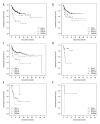Risk Factors for Graft-Versus-Host Disease After Transplantation of Hematopoietic Stem Cells from Unrelated Donors in the China Marrow Donor Program
- PMID: 28652564
- PMCID: PMC6248289
- DOI: 10.12659/aot.902805
Risk Factors for Graft-Versus-Host Disease After Transplantation of Hematopoietic Stem Cells from Unrelated Donors in the China Marrow Donor Program
Abstract
BACKGROUND We identified risk factors for acute and chronic graft-versus-host disease (aGVHD and cGVHD, respectively) in recipients after hematopoietic stem cell transplantation (HSCT) from unrelated donors in the China Marrow Donor Program (CMDP). MATERIAL AND METHODS We analyzed follow-up clinical information from 1824 patients who underwent HSCT between 2001 and 2010. RESULTS The incidence of aGVHD and cGVHD after transplantation was 49.29% and 27.3%, respectively. aGVHD incidence decreased as HLA matching increased (p<0.001). Incidence of aGVHD and cGVHD was higher in 2 HLA-A locus donor/recipient groups (02: 01/02: 06 and 02: 01/02: 07; p≤0.022). aGVHD incidence was associated with patient age, absence of rabbit anti-thymocyte globulin (ATG) pretreatment, and disease status (p≤0.040). aGVHD appeared to be a risk factor for cGVHD, and total body irradiation (TBI) was also associated with cGVHD. Patients with cGVHD after transplantation had a higher survival rate than patients without cGVHD (p<0.001), which may be due to reduced relapse rates. Survival was also associated with ATG prophylaxis and disease status. CONCLUSIONS The incidence of GVHD after HSCT from unrelated donors in the Chinese population is similar to the results reported from other countries. A high degree of HLA matching, a conditioning regimen without TBI, and the use of ATG may reduce the incidence of aGVHD.
Conflict of interest statement
The authors declare they have no conflict of interest.
Figures





Similar articles
-
Donor-Recipient Matching for KIR Genotypes Reduces Chronic GVHD and Missing Inhibitory KIR Ligands Protect against Relapse after Myeloablative, HLA Matched Hematopoietic Cell Transplantation.PLoS One. 2016 Jun 24;11(6):e0158242. doi: 10.1371/journal.pone.0158242. eCollection 2016. PLoS One. 2016. PMID: 27341514 Free PMC article.
-
[The impact of donor-to-recipient gender compatibility on outcomes of haploid hematopoietic stem cell transplantation in patients with hematological malignancies].Zhonghua Xue Ye Xue Za Zhi. 2022 Dec 14;43(12):992-1002. doi: 10.3760/cma.j.issn.0253-2727.2022.12.004. Zhonghua Xue Ye Xue Za Zhi. 2022. PMID: 36709104 Free PMC article. Chinese.
-
Risk factors for chronic graft-versus-host disease after anti-thymocyte globulin-based haploidentical hematopoietic stem cell transplantation in acute myeloid leukemia.Front Med. 2019 Dec;13(6):667-679. doi: 10.1007/s11684-019-0702-z. Epub 2019 Sep 11. Front Med. 2019. PMID: 31512033
-
[Treatment of Gaucher disease with allogeneic hematopoietic stem cell transplantation: report of three cases and review of literatures].Zhonghua Er Ke Za Zhi. 2015 Nov;53(11):810-6. Zhonghua Er Ke Za Zhi. 2015. PMID: 26758318 Review. Chinese.
-
Ocular graft-versus-host disease: Risk factors of ocular graft-versus-host disease after allogeneic haematopoietic stem cell transplantation in Denmark.Acta Ophthalmol. 2025 Apr;103 Suppl 286(Suppl 286):3-19. doi: 10.1111/aos.17452. Acta Ophthalmol. 2025. PMID: 40211651 Free PMC article. Review.
Cited by
-
Feasibility of salvage cord blood transplantation using a fludarabine, melphalan, and low-dose anti-thymocyte globulin conditioning regimen.Int J Hematol. 2019 Apr;109(4):463-469. doi: 10.1007/s12185-019-02610-4. Epub 2019 Feb 8. Int J Hematol. 2019. PMID: 30734904
-
[Comparison of umbilical cord blood transplantation and hematopoietic stem cell transplantation from HLA-matched sibling donors in the treatment of myelodysplastic syndrome-EB or acute myeloid leukemia with myelodysplasia-related changes].Zhonghua Xue Ye Xue Za Zhi. 2019 Apr 14;40(4):294-300. doi: 10.3760/cma.j.issn.0253-2727.2019.04.006. Zhonghua Xue Ye Xue Za Zhi. 2019. PMID: 31104440 Free PMC article. Chinese.
-
iNKT cells coordinate immune pathways to enable engraftment in nonconditioned hosts.Life Sci Alliance. 2021 Jun 10;4(7):e202000999. doi: 10.26508/lsa.202000999. Print 2021 Jul. Life Sci Alliance. 2021. PMID: 34112724 Free PMC article.
-
Phase 2 Study of Anti-Human Cytomegalovirus Monoclonal Antibodies for Prophylaxis in Hematopoietic Cell Transplantation.Antimicrob Agents Chemother. 2020 Mar 24;64(4):e02467-19. doi: 10.1128/AAC.02467-19. Print 2020 Mar 24. Antimicrob Agents Chemother. 2020. PMID: 32015031 Free PMC article. Clinical Trial.
-
[Chinese expert consensus on the diagnosis and treatment of acute graft-versus-host disease after hematopoietic stem cell transplantation (2024)].Zhonghua Xue Ye Xue Za Zhi. 2024 Jun 14;45(6):525-533. doi: 10.3760/cma.j.cn121090-20240608-00214. Zhonghua Xue Ye Xue Za Zhi. 2024. PMID: 39134482 Free PMC article. Chinese.
References
-
- Bensinger WI, Martin PJ, Storer B, et al. Transplantation of bone marrow as compared with peripheral-blood cells from HLA-identical relatives in patients with hematologic cancers. N Engl J Med. 2001;344:175–81. - PubMed
-
- Lown RN, Shaw BE. Beating the odds: factors implicated in the speed and availability of unrelated haematopoietic cell donor provision. Bone Marrow Transplant. 2013;48:210–19. - PubMed
-
- Tanaka J, Imamura M, Kasai M, et al. The important balance between cytokines derived from type 1 and 2 helper T Cell in the control of graft-versus-host disease. Bone Marrow Transplant. 1997;19:571–76. - PubMed
-
- Ju XP, Xu B, Xiao ZP, et al. Cytokine expression during acute graft-versusu-host disease after allofeneic peripheral stem cell transplantation. Bone Marrow Transplant. 2005;35:1179–86. - PubMed
MeSH terms
Substances
LinkOut - more resources
Full Text Sources
Research Materials

